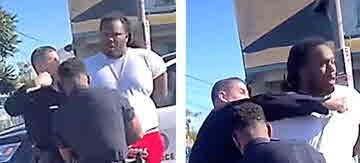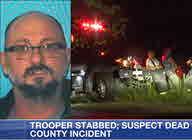|
Posted 8/11/24
“DISTRACTION STRIKE”? ANGRY PUNCH? BOTH?
When cops get rattled, the distinction may ring hollow

For Police Issues by Julius (Jay) Wachtel. Delivered in L.A.’s crime and poverty-beset Watts neighborhood by a clearly angry cop, that notorious punch rocked far more than its beefy victim. Within moments of the officers’ approach to Alexander Mitchell’s double-parked, wrong-way Dodge Charger (the car on the right), residents closed in with cell phones in hand. Less than four-and-one-half minutes later, as two regular-size cops struggled to handcuff the ornery, six-foot-four, 280-pound citizen, bystander videos captured a “distraction strike” that will surely go down in infamy.

LAPD released both officers’ bodycams (click here). They cover the same 30-minute period, 5:15 to 5:44 p.m., Sunday, July 28, and are in two parts, with the driver-side officer first. Simply connecting with Mr. Mitchell proved challenging. Heavily tinted windows blocked view of the car’s interior, so the wary driver-side officer looked in with a penlight. He asked that the window be rolled down, and Mr. Mitchell complied. But he became quarrelsome when the officer asked for ID, objecting that “I’m not on probation or parole”.
Click here for the complete collection of compliance and force essays
After Mr. Mitchell repeatedly ignored requests for I.D. the officer ordered him to step out of the vehicle. Mr. Mitchell grudgingly complied, but violently resisted an attempt to pat him down. Although the officer didn’t announce his intentions, we assume that he was arresting Mr. Mitchell for failure to comply with the lawful orders of a peace officer (i.e., present a driver license.) According to LAPD, Mr. Mitchell was ultimately booked for a misdemeanor violation of Penal Code section 148, resisting, delaying or obstructing a public safety officer. He was cited and released, and a court date is pending.
Throughout the struggle, Mr. Mitchell repeatedly asserted that that he knew the (correct?) “protocol” and was “not on probation or parole”. More citizens arrived, and their sympathies clearly didn’t lie with the cops. Several began filming away.

Mr. Mitchell’s size forced officers to use two pairs of handcuffs. Their commands to “put your hands behind your back,” though, fell on deaf ears. Repeatedly intoning “what did I do?”, Mr. Mitchell made affixing the second set impossible (left image depicts the passenger-side officer.) About four minutes into the tangle officers wrestled Mr. Mitchell back to the patrol car. That’s when the driver’s-side cop delivered that blow (second image portrays the moment just after the strike). While the punch instantly aroused spectator scorn (third image), it did seem to slow the large man down, “enabling the officers to complete the handcuffing” (LAPD’s initial assessment.) Moments later, the second pair of cuffs were affixed (right image).
For a brief bystander video of the punch, click here. For our edited, 1½ minute compilation of the key aspects of the encounter, including officer and bystander footage, click here.

Many more officers arrived. More passers-by also appeared, and they sauntered through the area mostly unimpeded. Meanwhile, a now fully-cuffed Mr. Mitchell kept resisting. “What did I do?” he repeatedly demanded. And when told that he was going to jail, he complained “I didn’t do nothing”. As officers struggled to place him in a police car, his objections morphed into “I can’t breathe.” Complaining about passing out, he soon went more-or-less limp.
Officers placed Mr. Mitchell on the ground and summoned paramedics. They soon arrived and placed him on a gurney. That’s when the (now, compliant) patient noticed that his car was being driven away.
“Why you taking my car?” he asked.
According to Mr. Mitchell’s lawyer, the encounter broke his client’s nose and left him with jaw pain. “It was brutal, it was uncalled for, it was unjustified,” complains attorney Brad Gage. As one would expect, he’s preparing a claim (precursor to a lawsuit) against the city.
This wasn’t Mr. Mitchell’s first tangle with the law. Our search of civil and criminal records revealed that his family hails from the Lone Star State. Texas criminal record no. 50226672 indicates that a man variously known as Alexander Donta Goffney, Alexander Goffney-Mitchell, and Alexander Donta Mitchell had two encounters with the state’s criminal justice system:
|
Date
|
Type
|
Details
|
|
4/7/2022
|
Adult dispositions
|
Both below cases convicted as misdemeanors, concurrent 1 yr. sentences
|
|
10/6/2021
|
Felony arrest
|
Violate protective order, 2+ prior convictions
|
|
10/30/2020
|
Felony arrest
|
Aggravated assault w/ serious injury, family member
|
|
 Why are we confident that these entries are about “our” Why are we confident that these entries are about “our”  Mr. Mitchell? His birthdate on Texas records is consistent with his chronological age (28) as reported by LAPD and other sources. “Goffney” is also very close to “Gofferney”, the middle name ascribed to Mr. Mitchell on the LAPD report and elsewhere. And a somewhat dated photo from Mr. Mitchell’s Texas record (see left) seems a dead ringer for the facial images captured by LAPD and passer-by bodycams (LAPD on right). Mr. Mitchell? His birthdate on Texas records is consistent with his chronological age (28) as reported by LAPD and other sources. “Goffney” is also very close to “Gofferney”, the middle name ascribed to Mr. Mitchell on the LAPD report and elsewhere. And a somewhat dated photo from Mr. Mitchell’s Texas record (see left) seems a dead ringer for the facial images captured by LAPD and passer-by bodycams (LAPD on right).
As this intriguing episode wends its way through the criminal, civil justice (i.e., lawsuit) and police disciplinary systems, two aspects of the encounter provoked our interest. First - and most importantly - the reason for the arrest.
 |
Click here for the driver-side officer’s initial, one-minute interaction with Mr. Mitchell. After using a penlight to confirm that the car was occupied (left image), the officer asked the driver to lower the window. Mr. Mitchell did so (second image), then promptly demanded to know “what’s going on?” In a low-key, conversational tone, the officer asked for a license and I.D. (third image) But Mr. Mitchell ignored him. Instead, he repeated “what’s going on?” and added “I’m not on probation or parole.” And when the cop (again, in a mild voice) pointed out that Mr. Mitchell was double parked and facing the wrong way, his antagonist countered with “what does that mean, I’m not on probation or parole”. With the exchange seemingly going nowhere, the officer soon accused Mr. Mitchell of “ignoring” him and politely asked that he step out of the car. Again complaining that he wasn’t “on probation or parole,” Mr. Mitchell did so (right image.) That’s when the officer moved in. And when the fight began.
Once again, consider the circumstances the officers encountered. Mr. Mitchell’s car was double-parked and facing the wrong way. Its windows were blacked out all around. And its driver’s ornery, challenging attitude must have provoked suspicions about his intentions. Why didn’t the cop demand Mr. Mitchell’s driver license from the very start? After all, he could have then simply ordered him to move the car. Job done!
But he didn’t. He then moved in, seemingly to make a physical arrest. Was there sufficient cause?
That brings us to our other concern: the need for the punch. The officer is reportedly still on the job but off the street. His supervisor, though, has filed a personnel complaint, and a use-of-force investigation is underway. However, the cop’s prospects aren’t completely grim. As mentioned above, LAPD credited the punch with resolving the situation. In fact, “distraction strikes” are widely recognized throughout cop-land as a “decisive means to regain control of an encounter.” Still, they’re not part of the California State peace officer curriculum. Former LAPD Chief William J. Bratton actually banned use of the term because he thought it could invite misconduct. However, an official March 2023 LAPD directive authorizes officers to use “strikes and kicks” when doing so is necessary to “overcome active resistance to arrest, create distance from a suspect, protect self or others from injury, stop or stun a suspect, and distract a suspect.”
Be sure to check out our homepage and sign up for our newsletter
But did it have to get to that point? Let’s self-plagiarize from our essay in The Crime Report:
How can cops make it more likely that crooks and ordinary citizens will voluntarily comply? De-escalation – slowing things down, providing distance, avoiding the use of threats – can be a useful approach. Yet, as I discovered on the job, defusing potentially explosive, rapidly-evolving encounters doesn’t always come from being “nice.” Indeed, a few folks seem to consider courtesy as an invitation to misbehave. Avoiding violence might require firmness. Displaying weapons and using less-than-lethal means might even be called for.
 A recent study of officer-citizen interactions captured on police bodycams concludes that suspects were more likely to comply with officers who “presented a positive tenor/demeanor or employed noncoercive verbal tactics.” But for an ornery few, nothing helped. While we’re not sold on the approach employed by the driver’s-side cop, considering Mr. Mitchell’s uncompliant nature, maybe there really was no hope. Still, as we mentioned in “Blows to the Head Were Never O.K.”, kicks and punches to the head are not an accepted practice. Even Officer.com’s relatively permissive piece recommends that distraction strikes be delivered “somewhere in the neck area with the edge of the hand or arm.” Considering Mr. Mitchell’s size, strength and combativeness, the only realistic alternatives might have been to deliver multiple blows from a club, multiple strikes from a Taser, or have additional officers join in. Problem is, as we discussed in “Piling On,” and “Policing is a Contact Sport (II)”, each of these practices carry substantial risks. A recent study of officer-citizen interactions captured on police bodycams concludes that suspects were more likely to comply with officers who “presented a positive tenor/demeanor or employed noncoercive verbal tactics.” But for an ornery few, nothing helped. While we’re not sold on the approach employed by the driver’s-side cop, considering Mr. Mitchell’s uncompliant nature, maybe there really was no hope. Still, as we mentioned in “Blows to the Head Were Never O.K.”, kicks and punches to the head are not an accepted practice. Even Officer.com’s relatively permissive piece recommends that distraction strikes be delivered “somewhere in the neck area with the edge of the hand or arm.” Considering Mr. Mitchell’s size, strength and combativeness, the only realistic alternatives might have been to deliver multiple blows from a club, multiple strikes from a Taser, or have additional officers join in. Problem is, as we discussed in “Piling On,” and “Policing is a Contact Sport (II)”, each of these practices carry substantial risks.
So we’re back to square one. A more (verbally) forceful approach might have peacefully resolved the problem of a double-parked car. While the underlying reason for Mr. Mitchell’s presence would have remained a mystery, in these troubled, deeply polarized times, half a loaf isn’t bad.
Did you enjoy this post? Be sure to explore the homepage and topical index!
Home Top Permalink Print/Save Feedback
RELATED ARTICLES
“How to Defuse Police-Civilian Encounters”
“Finding the path of least resistance: An examination of officer communication tactics and their impact on suspect compliance”
RELATED POSTS
Piling On Blows to the Head Were Never O.K. Fair But Firm Policing is a Contact Sport (II)
Posted 7/30/24
BRINGING A GUN TO A KNIFE FIGHT
Cops carry guns. Some citizens flaunt knives. Are poor outcomes inevitable?

For Police Issues by Julius (Jay) Wachtel. “Bringing a gun to a knife fight.” That provocative (some might say, incendiary) idiom is how the Los Angeles Times led off its recent analysis of fifty-six episodes since 2018 when LAPD officers fired at “people in crisis” who were flaunting “edged weapons”, killing thirty-five and injuring nineteen.
Two of these events took place only one day apart. We obtained the details from the LAPD Newsroom:
 January 2, 2023: Officers responded to a 9-1-1 call that Takar Smith was in an apartment in violation of a restraining order. Smith refused repeated requests to leave, and after a prolonged back-and-forth he grabbed “a large knife” from the kitchen (see right). Officers tasered Smith and doused him with pepper spray. Smith dropped the knife. But he then grabbed it again and “raised it above his head.” Officers shot him dead. January 2, 2023: Officers responded to a 9-1-1 call that Takar Smith was in an apartment in violation of a restraining order. Smith refused repeated requests to leave, and after a prolonged back-and-forth he grabbed “a large knife” from the kitchen (see right). Officers tasered Smith and doused him with pepper spray. Smith dropped the knife. But he then grabbed it again and “raised it above his head.” Officers shot him dead.
January 3, 2023: Only one day after the fatal encounter with Smith, officers in  another beset LAPD Division were alerted that a suspect later identified as Oscar Sanchez threw a metal object at a passing car, then threatened its driver with a knife. When confronted in the abandoned home where he apparently lived, Sanchez quickly “stepped toward” the officers holding a “two-foot-long metal object with an approximate three-inch spike protruding from one end” (see right.) Officers simultaneously fired a gun and a “less lethal” weapon, inflicting a fatal wound. another beset LAPD Division were alerted that a suspect later identified as Oscar Sanchez threw a metal object at a passing car, then threatened its driver with a knife. When confronted in the abandoned home where he apparently lived, Sanchez quickly “stepped toward” the officers holding a “two-foot-long metal object with an approximate three-inch spike protruding from one end” (see right.) Officers simultaneously fired a gun and a “less lethal” weapon, inflicting a fatal wound.
Click here for the complete collection of compliance and force essays
LAPD reportedly ruled eight of these shootings “out of policy,” meaning that officers violated rules and procedures that are intended to prevent causing needless harm. (In two, police bullets struck aggressors’ intended victim.) As for the above examples, one was declared “in policy”, the other not.
Can you guess which?
 According to the L.A. Times, LAPD Chief Michel Moore and the Police Commission agreed that the first shooting, of Takar Smith, was “out of policy”. Less-lethal measures (bodycam image shows him being Tasered) did fail to keep the knife from Mr. Smith’s hands. But he had barricaded himself with bicycles, and reviewers thought that there was enough time to summon a mental evaluation team that could defuse things. Chief Moore felt that the officers should have backed off and come up with a better game plan. According to the L.A. Times, LAPD Chief Michel Moore and the Police Commission agreed that the first shooting, of Takar Smith, was “out of policy”. Less-lethal measures (bodycam image shows him being Tasered) did fail to keep the knife from Mr. Smith’s hands. But he had barricaded himself with bicycles, and reviewers thought that there was enough time to summon a mental evaluation team that could defuse things. Chief Moore felt that the officers should have backed off and come up with a better game plan.
Click on the image for the video (officer interaction with Mr. Smith begins at 1:02). What do you think? Should the cop have fired?
 Now compare that to what happened to Mr. Oscar Sanchez on the very next day. That’s him at the top of the stairs, by the door to his pad (click on the image for the LAPD video.) According to the Chief and the Commission, his shooting, while not the best outcome, was nonetheless “in policy.” There were some notable differences from what happened with Mr. Smith on the previous day. Several officers and a supervisor had repeatedly tried to gain Mr. Sanchez’s compliance, but he resisted them all. And when he suddenly wielded that nasty spiked object, there were no bicycles between him and the cops. Now compare that to what happened to Mr. Oscar Sanchez on the very next day. That’s him at the top of the stairs, by the door to his pad (click on the image for the LAPD video.) According to the Chief and the Commission, his shooting, while not the best outcome, was nonetheless “in policy.” There were some notable differences from what happened with Mr. Smith on the previous day. Several officers and a supervisor had repeatedly tried to gain Mr. Sanchez’s compliance, but he resisted them all. And when he suddenly wielded that nasty spiked object, there were no bicycles between him and the cops.
In our gun-beset land, shootings are always in the news. Stabbings typically draw far less attention. While knives and other cutting instruments are far less likely than guns to inflict a fatal injury, there’s no denying that they also pose a grave risk. We used the CDC’s WISQARS database and the UCR’s Crime Data Explorer to probe injuries and deaths from shootings and stabbings in 2022, the most recent year for which full data is available.

We’ll start with the graphs on the left. According to the CDC, 161,794 victims of violence sustained gunshot wounds in 2022. About 12 percent proved fatal. During the same year, domestic emergency rooms treated 309,205 persons who had been violently cut or stabbed. Fewer than one percent of these injuries were fatal. Our graph on the right uses UCR data to show how law enforcement officers were affected. During the same year about 47% more officers (398 v. 270) were injured by firearms than with cutting instruments. About 14 percent of gunshot injuries to officers proved fatal; none who were cut or stabbed died.
Numbers alone can’t enlighten us about the nature of violent citizen-police encounters. What brought on the carnage? Might it have been averted? A July 8th. Google query of “officer stabbed”  generated ten episodes for 2024, nine in the U.S. and one in Canada. Here are four (incident dates shown): generated ten episodes for 2024, nine in the U.S. and one in Canada. Here are four (incident dates shown):
May 8, 2024: A West Virginia trooper was stabbed twice with a knife while pursuing a man (depicted on right) who fled on foot from a traffic stop. A fellow trooper shot and killed the assailant. The trooper was seriously injured but is recovering.
 May 18, 2024: According to D.C. police, an ill-behaving man being taken into custody to be evaluated for a mental health issue pulled a pocket knife and stabbed an officer in the neck. A Taser had no effect, and another officer wound up shooting the assailant. Fortunately, everyone survived. (Click here for the MPD news release) May 18, 2024: According to D.C. police, an ill-behaving man being taken into custody to be evaluated for a mental health issue pulled a pocket knife and stabbed an officer in the neck. A Taser had no effect, and another officer wound up shooting the assailant. Fortunately, everyone survived. (Click here for the MPD news release)
July 7, 2024: “An individual acting bizarrely” walked up to a Kansas City police officer in a parking lot and, without warning, produced a “sharp object” and stabbed him twice. The assailant ran off; the officer is recovering.
 February 11, 2024: Tragically, not every officer survived their encounter. Las Cruces, New Mexico police were alerted about a man who trespassed on a business. As Officer Jonah Hernandez approached, the suspect suddenly attacked with the knife he was carrying in his right hand (see bodycam image). Officer Hernandez suffered fatal wounds to his head and neck. An armed passer-by shot and killed the assailant. Armando Silva, 29, had “a long history of violent crime and mental illness.” February 11, 2024: Tragically, not every officer survived their encounter. Las Cruces, New Mexico police were alerted about a man who trespassed on a business. As Officer Jonah Hernandez approached, the suspect suddenly attacked with the knife he was carrying in his right hand (see bodycam image). Officer Hernandez suffered fatal wounds to his head and neck. An armed passer-by shot and killed the assailant. Armando Silva, 29, had “a long history of violent crime and mental illness.”
So what’s to be done? What can be done? As your blogger learned during the many conflicted situations he and his colleagues encountered, gaining citizen compliance is definitely Job #1. But complications abound. Clashing officer perspectives can easily lead to poor endings. What officers observe – or think they observe – depends on when they arrive, where they wind up, and how they interpret what they see (or “think” they see). In the quickly-evolving, conflicted atmosphere of the streets, promptly – and accurately – figuring out who’s “good” and who’s “bad” is essential.
Gunning down the mentally disturbed is an inherently repulsive thought. And in our post-Floyd atmosphere, there is undeniable pressure to blame the cops, and only the cops. So while we don’t hesitate calling out poor policing – see, for example, “Confirmation Bias Can be Lethal” – retrospective analyses are invariably fraught. Given the complexities of what the officers faced, and the rapidly evolving nature of the encounters, is it possible to accurately assess, post-facto, whether the shootings of Takar Smith and Oscar Sanchez were avoidable?
 Consider the notorious killing of Tamir Rice, the 12-year old who was shot dead in November 2014 by then-Cleveland police officer Timothy Loehmann. We delved into that incident in “Working Scared”. Loehmann wasn’t disciplined over the shooting. After all, Tamir had been flaunting “a realistic-looking pellet gun” (image on left) and the circumstances of their encounter were decidedly complex (click here for a detailed news account and here for a video.) Consider the notorious killing of Tamir Rice, the 12-year old who was shot dead in November 2014 by then-Cleveland police officer Timothy Loehmann. We delved into that incident in “Working Scared”. Loehmann wasn’t disciplined over the shooting. After all, Tamir had been flaunting “a realistic-looking pellet gun” (image on left) and the circumstances of their encounter were decidedly complex (click here for a detailed news account and here for a video.)
Inquiries into officer Loehmann’s background turned up some disquieting information. Loehmann had been turned away by several agencies before being hired by Cleveland. A small department had taken him on, and its deputy chief said he came to regret it: “He could not follow simple directions, could not communicate clear thoughts nor recollections, and his handgun performance was dismal…I do not believe time, nor training, will be able to change or correct the deficiencies…”
Cleveland fired Loehmann in 2017, not for the shooting but over alleged “inaccuracies” in his employment application. Loehmann then kept bouncing around agencies. On July 1, 2024, “public outrage” over the decade-earlier killing of Tamir Rice led him to resign from a small police department in West Virginia. Here’s how its Chief explained Loehmann’s hiring:
Just as a person, I looked at the whole situation. I did a background check. I researched everything. It’s just a sad situation. Does any police officer in the world stand a chance when they’re involved in a shooting? Do they deserve to never work again as a police officer, or is it just this shooting?
Here’s what Tamir Rice’s mother recently said:
I just don’t get it. This system is so broken. It’s like this man is haunting me. How can any department trust him? I don’t think anything has changed in the last ten years.
And here’s what her lawyer recently said:
Timothy Loehmann should be radioactive to any responsible community or law enforcement organization.
 Cops who bounce around agencies continue to be in the news. As does their handiwork. Most recently, there’s the July 6th. 2024 shooting death of Sonya Massey, a troubled Springfield, Illinois woman who called 9-1-1 about a prowler. For reasons still unclear, Ms. Massey apparently threatened then-deputy sheriff Sean Grayson with a pot of boiling water after he entered her home. She then reportedly apologized. But Grayson, who kept his distance throughout, opened fire, killing her (click on image for the bodycam video). He then discouraged his partner from rendering aid. Grayson, who’s been jailed on 1st. degree murder charges, bounced around six agencies during his four-year law enforcement career. Three were as a part-timer at small police departments, which hired him despite a driving record that included two DUI’s. His most recent job, as a Sangamon County deputy, began in May 2023. It followed on a year-long stint with the Logan County sheriff, a position that he resigned after issues over his performance arose. Cops who bounce around agencies continue to be in the news. As does their handiwork. Most recently, there’s the July 6th. 2024 shooting death of Sonya Massey, a troubled Springfield, Illinois woman who called 9-1-1 about a prowler. For reasons still unclear, Ms. Massey apparently threatened then-deputy sheriff Sean Grayson with a pot of boiling water after he entered her home. She then reportedly apologized. But Grayson, who kept his distance throughout, opened fire, killing her (click on image for the bodycam video). He then discouraged his partner from rendering aid. Grayson, who’s been jailed on 1st. degree murder charges, bounced around six agencies during his four-year law enforcement career. Three were as a part-timer at small police departments, which hired him despite a driving record that included two DUI’s. His most recent job, as a Sangamon County deputy, began in May 2023. It followed on a year-long stint with the Logan County sheriff, a position that he resigned after issues over his performance arose.
Be sure to check out our homepage and sign up for our newsletter
Here’s an extract from the IACP’s message to its members about the killing of Ms. Massey:
While the facts are still being gathered, and the former deputy is entitled to due process, the killing of Sonya Massey was a devastating and avoidable tragedy. The shooting again underscores the critical need for police agencies to thoroughly vet potential hires. The pattern and nature of frequent job changes by a police officer should raise flags about their suitability for the policing profession.
And here’s what we wrote, um, eight years ago:
Alas, the hiring process isn’t infallible. Even good screening measures fail. That’s why it’s essential to closely monitor recruits in the academy and during their first years in the field. That’s not foolproof either. Every working officer knows cops who have poor people skills or are prone to overreact, leaving messes for colleagues to clean up. Fortunately, no one usually dies and things get papered over until next time. Occasionally, though, there is no “next time.”
Until next time!
UPDATES (scroll)
4/9/25 Pocatello, ID police were alerted by a 911 caller that a seemingly drunk, knife-armed youth had been chasing persons in the backyard of a nearby home. Victor Perez, 17, was lying inside a chain-linked fenced yard, knife in hand, when officers arrived. Officers ordered him to drop the knife. But Perez, who is autistic, got up and walked towards the officers while gripping the knife. Perez’s sister reportedly yelled at the officers not to shoot. But they instantly opened fire, inflicting nine bullet wounds and leaving the youth in critical condition. Perez’s family members and residents are voicing their outrage. Note: Victor Perez was removed from life support and died on April 12. Video
3/17/25 Last November a 34-year old woman wielding a kife reportedly cornered an Independence, Missouri police officer who was in her residence on a domestic disturbance call. He opened fire, killing Maria Pike and, accidentally, her three-month old infant. Police had been summoned by the child’s grandmother, who reported that Ms. Pike “attacked” her when she went to see the child. Ms. Pike was visited by police before; she was also the subject of a Child Services inquiry. Prosecutors just announced that they will not file charges against the officer, whose reaction they consider “reasonable.”
3/10/25 In February a distraught Los Angeles woman called 911 and said that she was being held in a motel room and forced to perform sex work. Multiple LAPD officers arrived and interacted with Linda Moran, 30. She claimed to have been beaten; they examined her but found no sign of injuries. Moran soon became angry and ordered the officers to leave. They backed away and clustered at the door. Moran then slowly advanced on them with a large knife in hand. An officer opened fire, inflicting an ultimately fatal wound. LAPD released graphic, highly detailed clips from the officer bodycams. Video
2/13/25 Ten million dollars. That’s the settlement reached by Sangamon County, Illinois with the family of Sonya Massey, a disturbed woman who was shot dead last July by then-sheriff’s deputy Sean Grayson. Deputy Grayson was hired in 2023 despite concerns by other agencies about his skills and suitability for law enforcement. Captured on video, his shooting of Ms. Massey, who threatened him with a pot of water, was deemed wholly unnecessary. He remains in custody pending trial for murder. (See 9/9/24 update)
9/17/24 A knife-wielding man who advanced on NYPD officers at a Brooklyn subway station wasn’t stopped by their Tasers. So they opened fire, wounding him. But their bullets also wounded a police officer and two passengers, one critically. And in Los Angeles, officers exchanged fire with an armed man as they pursued him through commercial structures and a parking garage. Their suspect was ultimately shot dead, as was a citizen in a parked car. Whose bullets struck him has not yet been revealed.
9/9/24 An in-depth probe by The Intercept reveals that former Sangamon County, Illinois sheriff’s deputy Sean Grayson, who faces 1st. degree murder charges for shooting Sonya Massey, had frequently switched law enforcement jobs because of agency concerns about his honesty, truthfulness and competence. But these issues failed to be addressed during the background investigation by Sangamon County. One reason may be that none of his former employers had ever submitted any red flags about Grayson to the statewide database that tracks officer misconduct. (See 2/13/25 update)
8/26/24 Victoria Lee’s recent killing by Fort Lee police prompted New Jersey to enact the nation’s reportedly first statewide rules governing police encounters with mentally troubled persons. “Tactical disengagement” should always be considered, and unless there is an immediate threat of serious injury or death, taking forceful action must be delayed until “appropriate resources” are available and supervisors and mental health professionals have arrived. All officers must also have less-lethal weapons at hand. (See below update)
8/19/24 On July 28 Fort Lee, New Jersey police were called to an apartment where a mentally troubled 25-year old woman in a mental crisis was holding a knife. When an officer ordered her to open the door or have it knocked down, Victoria Lee threatened to stab him. Once the door was forced open, a bodycam video depicts her advancing on the officers holding a small knife in her left hand. And when Ms. Lee doesn’t drop the weapon as ordered, Officer Tony Pickens Jr. fires a single shot, killing her. Detailed A.G. account All bodycams (See above update)
8/15/24 Anchorage, Alaska police were summoned to an apartment where a young female resident was reportedly threatening her sister with a knife. Officers encountered the teen and ordered her to drop the knife. But she reportedly advanced on them, knife in hand. Two officers opened fire: one discharged a less-lethal weapon, the other fired multiple shots from a pistol. Easter Leafa, 16, was mortally wounded. According to The Guardian, she recently relocated to Anchorage from American Samoa.
8/8/24 “I rebuke you in the name of Jesus.” Uttered by Sonya Massey as she brandished a pot of boiling water, these words allegedly demonstrated her lethal intent. Or so claims then-Sangamon county, Illinois deputy Sean Grayson, who is charged with murder for shooting the mentally disturbed woman dead after she called deputies to her home on July 6. “I was in imminent fear of getting boiling liquid to my face or chest, which would have caused great bodily harm or death” he wrote in his report. He has pled not guilty.
8/5/24 After talk and a Taser proved ineffective, L.A. County Sheriff’s deputies opened fire, critically wounding a 29-year old man who “aggressively” approached them wielding a large kitchen knife in one hand and a switchblade in the other. The as yet unidentified suspect had reportedly “swung a knife” at another person in a shopping center parking lot, then walked around seemingly looking for other victims. His record includes a prior arrest for “carrying knives and starting fires.”
8/2/24 One day before Sonya Massey summoned deputies to her home about a supposed prowler, her mother called 9-1-1 to inform them that her daughter was having mental issues. “I don’t want you guys to hurt her, please.” Donna Massey’s admonition apparently wasn’t passed on to Sangamon County, Illinois sheriff’s deputy Sean Grayson. On the very next day, during the encounter at the daughter’s residence, he shot Sonya Massey dead when she threatened him with a pot of boiling water.
|
Did you enjoy this post? Be sure to explore the homepage and topical index!
Home Top Permalink Print/Save Feedback
RELATED POSTS
Confirmation Bias Can be Lethal Working Scared
|